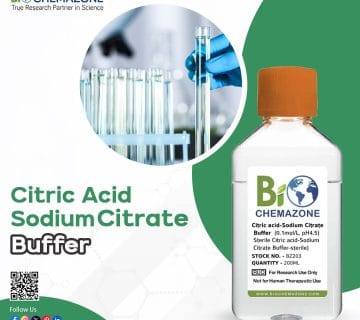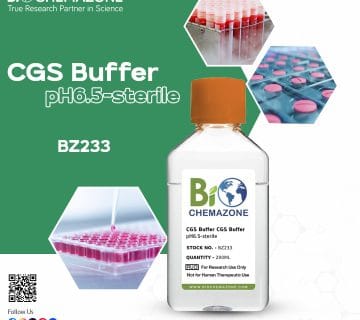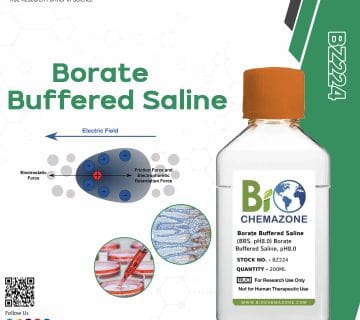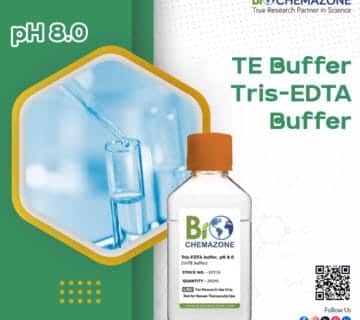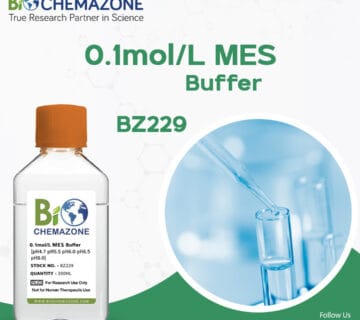The Ultimate Guide to PBS Phosphate Buffered Saline (1×PBS Buffer, pH 7.2-7.4) for Cell Culture and Research
Phosphate Buffered Saline (PBS) is an essential reagent in biological research and cell culture. It offers a stable ionic environment, maintains pH, and is isotonic with human blood, making it indispensable in numerous laboratory applications. In this comprehensive guide, we’ll delve into everything you need to know about PBS, its composition, preparation, applications, and best practices for use.
Buy PBS Phosphate Buffered Saline here: https://biochemazone.com/product/pbs-phosphate-buffered-saline-bz205/
What is PBS (Phosphate Buffered Saline)?
PBS is a water-based buffer solution that contains disodium hydrogen phosphate, sodium chloride, and, in some formulations, potassium chloride and potassium dihydrogen phosphate. Its key attributes include:
- Stable pH (7.2-7.4): Ideal for biological experiments.
- Isotonicity: Closely mimics the osmolarity of human blood.
- Non-toxicity: Compatible with cell cultures and molecular biology techniques.
This buffer is widely used in cell culture, molecular biology, and tissue transport due to its ability to maintain a stable environment.
Key Specifications of PBS Phosphate Buffered Saline
| Specification | Details |
|---|---|
| Buffer Types | 1×, 10×, customizable as required |
| pH Range | 7.2-7.4 (customizable) |
| Pack Sizes | 100 mL, 200 mL, 500 mL, 1000 mL |
| Storage Conditions | Room temperature; valid for 12 months |
| Sterilization | Pre-sterilized; ready to use |
Order customizable PBS buffer today!
Composition of 1×PBS Buffer (pH 7.4)
The components of a standard 1×PBS solution are carefully calculated to ensure isotonicity and pH stability:
| Component | Amount | Concentration |
|---|---|---|
| NaCl | 8 g | 0.137 M |
| KCl | 200 mg | 0.0027 M |
| Na2HPO4 | 1.44 g | 0.01 M |
| KH2PO4 | 245 mg | 0.0018 M |
Preparation Steps:
- Dissolve all components in 800 mL of distilled water.
- Adjust pH to ~7.4 using hydrochloric acid or sodium hydroxide.
- Top up with distilled water to reach a final volume of 1 L.
Applications of PBS in Research and Cell Culture
PBS plays a pivotal role in various laboratory applications. Let’s explore its primary uses:
1. Washing Cells and Tissues
PBS is commonly used to rinse cells and tissue samples to remove unwanted residues without causing harm to cellular structures.
2. Dilution Buffer
It serves as a diluent for reagents and samples in molecular biology protocols, such as PCR and ELISA.
3. Tissue and Cell Transport
PBS maintains the osmotic balance, making it ideal for transporting tissues and cells between experimental setups.
4. Storage Medium
PBS can temporarily store cellular materials, ensuring their stability during short-term storage.
5. Molecular Cloning
PBS is extensively used in the preparation of DNA and RNA samples due to its ability to maintain ionic stability.
Advantages of Using PBS in Biological Research
1. Isotonic Nature
PBS mimics the osmolarity of human blood, preventing cell lysis or shrinkage during experiments.
2. pH Stability
The buffer maintains a constant pH, critical for enzymatic and cellular activities.
3. Non-toxic Composition
PBS’s non-toxic nature ensures it doesn’t interfere with biological processes.
4. Versatility
From cell culture to protein purification, PBS is adaptable to various protocols.
5. Ready-to-Use Options
Pre-sterilized PBS solutions save time and minimize contamination risks.
Precautions for Using PBS
To ensure optimal results, it’s essential to follow these precautions while using PBS:
- Avoid Microbial Contamination:
- Use sterile techniques during handling.
- Store PBS in sterile containers.
- Handle Precipitation:
- PBS may precipitate at low temperatures.
- Dissolve precipitates by warming the solution in a 37°C water bath.
- Wear Protective Gear:
- Always use lab coats and gloves while working with PBS.
- pH Verification:
- Use a calibrated pH meter to ensure accuracy during preparation.
Comparison of 1× and 10× PBS Solutions
| Feature | 1× PBS | 10× PBS |
|---|---|---|
| Concentration | Ready-to-use, working buffer | Requires dilution before use |
| Applications | General laboratory use | Long-term storage or bulk use |
| Preparation Time | None; pre-sterilized | Requires dilution and pH adjustment |
Get high-quality PBS for your research needs here.
Storage and Shelf Life
Storage Conditions:
- Room temperature: Suitable for most applications.
- 4°C: Extends shelf life but not ideal for long-term storage.
- Avoid freezing as PBS may precipitate.
Shelf Life:
- Valid for 12 months under recommended storage conditions.
Preparing Customizable PBS Buffers
Customizable PBS solutions are ideal for specific experimental needs. Adjustments can include:
- pH Range: Modify pH for compatibility with particular assays.
- Ionic Strength: Alter salt concentrations for specialized applications.
- Pack Sizes: Order as per usage requirements (100 mL to 1000 mL).
Contact the supplier for customizable options tailored to your research protocols.
FAQs About PBS Phosphate Buffered Saline
1. What is the pH of PBS?
The standard pH of PBS is 7.2–7.4, ensuring stability for biological applications.
2. How should PBS be stored?
Store PBS at room temperature. For extended shelf life, refrigeration at 4°C is recommended.
3. Can PBS be frozen?
Freezing is not advisable as it can lead to precipitation of salts.
4. How is PBS used in cell culture?
PBS is used to wash cells, dilute reagents, and maintain isotonic conditions.
5. Is PBS toxic to cells?
No, PBS is non-toxic and widely used in experiments involving live cells.
6. Can I adjust the pH of PBS?
Yes, the pH can be adjusted using hydrochloric acid or sodium hydroxide.
Conclusion
PBS phosphate-buffered saline is a versatile and essential tool in biological research and cell culture. Its stable pH, isotonicity, and ease of preparation make it a cornerstone reagent in laboratories worldwide. Whether you need a standard 1×PBS or a customizable formulation, PBS ensures reproducibility and reliability in your experiments.
Order PBS Phosphate Buffered Saline today for your laboratory needs!


